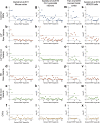Genetic association of FMRP targets with psychiatric disorders
- PMID: 33077856
- PMCID: PMC8505260
- DOI: 10.1038/s41380-020-00912-2
Genetic association of FMRP targets with psychiatric disorders
Abstract
Genes encoding the mRNA targets of fragile X mental retardation protein (FMRP) are enriched for genetic association with psychiatric disorders. However, many FMRP targets possess functions that are themselves genetically associated with psychiatric disorders, including synaptic transmission and plasticity, making it unclear whether the genetic risk is truly related to binding by FMRP or is alternatively mediated by the sampling of genes better characterised by another trait or functional annotation. Using published common variant, rare coding variant and copy number variant data, we examined the relationship between FMRP binding and genetic association with schizophrenia, major depressive disorder and bipolar disorder. High-confidence targets of FMRP, derived from studies of multiple tissue types, were enriched for common schizophrenia risk alleles, as well as rare loss-of-function and de novo nonsynonymous variants in schizophrenia cases. Similarly, through common variation, FMRP targets were associated with major depressive disorder, and we present novel evidence of association with bipolar disorder. These relationships could not be explained by other functional annotations known to be associated with psychiatric disorders, including those related to synaptic structure and function. This study reinforces the evidence that targeting by FMRP captures a subpopulation of genes enriched for genetic association with a range of psychiatric disorders.
© 2020. The Author(s).
Conflict of interest statement
JH, AJP, MCOD, JTRW and MJO are supported by a collaborative research grant from Takeda Pharmaceuticals. Takeda played no part in the conception, design, implementation, or interpretation of this study.
Figures



Similar articles
-
FMRP and CYFIP1 at the Synapse and Their Role in Psychiatric Vulnerability.Complex Psychiatry. 2020 Oct;6(1-2):5-19. doi: 10.1159/000506858. Epub 2020 Mar 3. Complex Psychiatry. 2020. PMID: 34883502 Free PMC article. Review.
-
mRNA and protein expression for novel GABAA receptors θ and ρ2 are altered in schizophrenia and mood disorders; relevance to FMRP-mGluR5 signaling pathway.Transl Psychiatry. 2013 Jun 18;3(6):e271. doi: 10.1038/tp.2013.46. Transl Psychiatry. 2013. PMID: 23778581 Free PMC article.
-
Enrichment of the Local Synaptic Translatome for Genetic Risk Associated With Schizophrenia and Autism Spectrum Disorder.Biol Psychiatry. 2024 May 1;95(9):888-895. doi: 10.1016/j.biopsych.2023.12.006. Epub 2023 Dec 14. Biol Psychiatry. 2024. PMID: 38103876
-
Exome Sequencing of Familial Bipolar Disorder.JAMA Psychiatry. 2016 Jun 1;73(6):590-7. doi: 10.1001/jamapsychiatry.2016.0251. JAMA Psychiatry. 2016. PMID: 27120077 Free PMC article.
-
The role of fragile X mental retardation protein in major mental disorders.Neuropharmacology. 2011 Jun;60(7-8):1221-6. doi: 10.1016/j.neuropharm.2010.11.011. Epub 2010 Nov 22. Neuropharmacology. 2011. PMID: 21108954 Free PMC article. Review.
Cited by
-
Schizophrenia Risk Mediated by microRNA Target Genes Overlapped by Genome-Wide Rare Copy Number Variation in 22q11.2 Deletion Syndrome.Front Genet. 2022 Apr 15;13:812183. doi: 10.3389/fgene.2022.812183. eCollection 2022. Front Genet. 2022. PMID: 35495153 Free PMC article.
-
Neuroimaging Insight Into Fragile X-Associated Neuropsychiatric Disorders: Literature Review.Front Psychiatry. 2021 Oct 15;12:728952. doi: 10.3389/fpsyt.2021.728952. eCollection 2021. Front Psychiatry. 2021. PMID: 34721105 Free PMC article.
-
FMRP and CYFIP1 at the Synapse and Their Role in Psychiatric Vulnerability.Complex Psychiatry. 2020 Oct;6(1-2):5-19. doi: 10.1159/000506858. Epub 2020 Mar 3. Complex Psychiatry. 2020. PMID: 34883502 Free PMC article. Review.
-
Genetic Implication of Specific Glutamatergic Neurons of the Prefrontal Cortex in the Pathophysiology of Schizophrenia.Biol Psychiatry Glob Open Sci. 2024 Jun 8;4(5):100345. doi: 10.1016/j.bpsgos.2024.100345. eCollection 2024 Sep. Biol Psychiatry Glob Open Sci. 2024. PMID: 39099730 Free PMC article.
-
Discovering functional interactions among schizophrenia-risk genes by combining behavioral genetics with cell biology.Neurosci Biobehav Rev. 2024 Dec;167:105897. doi: 10.1016/j.neubiorev.2024.105897. Epub 2024 Sep 14. Neurosci Biobehav Rev. 2024. PMID: 39278606 Free PMC article. Review.

